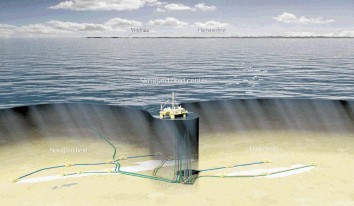
A $14.5-16.3billion joint-field development concept has been chosen by the partners of the Skrugard and Havis oil and gas discoveries in the Norwegian sector of the Barents Sea.
The collective prize between the two fields located just 7km apart is in the order of 400-600million barrels oil equivalent. Four further exploration targets could, if successful, add significantly to that estimate.
They form part of Statoil’s much larger Arctic programme, which stretches across the Atlantic and into North America.
The decision by Statoil and partners in the licences comes less than two years since Skrugard was found in April 2011 and less than a year since the nearby Havis find reinforced the economics of a future potential development.
The initial estimate for Skrugard was around 350million barrels, while the figure for Havis is 300-300million barrels recoverable.
Skrugard lies roughly 100km north of Statoil’s pioneering Snohvit field, 150km from Goliat, which is currently under development by operator Eni, and almost 230km from the hydrocarbons receiving terminal at Melkoya in Northern Norway.
The water depth at Skrugard is 380m.
It was in February 2011 that the Norwegian Petroleum Directorate granted Statoil a drilling permit for wellbore 7220/8-1 using the Polar Pioneer rig. This was drilled to a depth of 1,250m and led to the Skrugard discovery. That first well encountered a 33m (108ft) gas column and an oil column of 90m (295ft).
Statoil, with partners Eni and Petoro have decided that oil from the two new finds will be processed using a semi-submersible style floating production unit tied into subsea well clusters.
Conditioned oil will be sent via a 280km (170-mile) pipeline to a shore-based oil terminal at Veidnes, Honningsvag in Finnmark, so opening up another Norwegian coastal community to the economic impacts of offshore oil and gas. Oil will be stored in two huge caverns prior to export to market. Around 50 to 100 tanker loads a year would be shipped to market.
It is currently estimated that production levels from the development could reach 200,000 barrels oil equivalent per day.
A development plan is expected to be submitted next year with first oil to follow in 2018.
It is currently estimated that production levels from the development could reach 200,000 barrels oil equivalent per day.
Statoil has been exploring in the Barents Sea for more than 30 years and the company has been involved in 88 of a total 92 exploration wells drilled in the area.
This has resulted in a formidable knowledge of potential hydrocarbon resources in the region.
Moreover, the hunt will continue, with Statoil expecting to drill as many as nine exploration wells in the Barents this year alone.
Four will be in the Skrugard-Havis area, which Statoil (50%) holds in partnership with Eni (30%) and Petoro (20%).
Statoil will also drill in the Hoop area, the northernmost region to be explored in Norway.